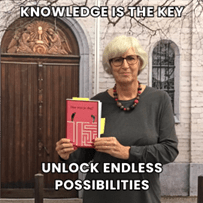"People who think that time is money usually only realize on their deathbed that their time is up but their money isn't." ― Alexander Pola
Have you ever felt like time was slipping through your fingers, even in the midst of retirement expectations or the hustle of your daily life? I vividly remember eagerly anticipating my retirement, expecting a sea of time lying ahead. Ironically, it seems that my schedule is now busier than ever before. Time is more precious than ever, and this awareness has led me to contemplate how we can do more in less time.
Fortunately, there are strategies you can apply to increase your productivity. Here are the first seven tips that can help you make the most of your time. Not necessarily to do more, but to have time left for what truly matters in life.
1. Make a plan and set priorities
It might seem contradictory when you have little time to spend a quarter-hour planning. However, without doing so, you lose a lot of time and energy hopping aimlessly from one task to another. Imagine that, through thoughtful planning, you discover that the work you do for one task is actually the key to success for another. By setting the right order, you can create synergy between tasks and handle them more efficiently. This prioritization prevents you from getting stuck in the multitude of small tasks that may not be essential and lead to a loss of time.
2. Avoid multitasking
This tip applies to both men and women. Even if you think you can do multiple things at once, it's actually an illusion. Instead of multitasking, you're constantly switching from one task to another. It's not surprising that studies have shown multitasking actually reduces your productivity. Concentrating on a single task leads to fewer mistakes and improves the quality of your work. Better focus also makes you work faster.
3. Take regular breaks or use the Pomodoro technique
Named after the tomato-shaped kitchen timer used by its creator, this Pomodoro technique involves working intensively on a task for 25 minutes and then taking a 5-minute break. These short, focused work periods can help you avoid distractions and keep your energy level high. Taking breaks is not only a well-deserved breather, but it also allows you to stay fresh and alert, increasing your productivity throughout the day.
4. Minimize distractions
To work with focus, it's important not to be distracted. If a background radio distracts you, turn it off. But more importantly, turn off your phone and all digital distractions. Each notification requires your attention and, therefore, time. Ensure you have a quiet workspace so that you aren't disturbed, or inform others that you are working.
5. Learn to say 'No'
It's easy to get overwhelmed when trying to please everyone. By learning to set boundaries and saying 'no' to tasks or obligations that don't align with your goals or priorities, you take care of your well-being and productivity. If you've made a priority list, you can easily refer to it to frame your 'no.'
6. Use technology
There are many digital tools designed to increase your productivity. Apps like Trello help you manage projects, Todoist helps you track task lists, and Google Calendar can assist you in managing your time. Choose the tools that best suit you and integrate them into your daily routine. However, remember that technology is a tool, not a goal in itself. It's an art to find the right balance so that technology actually enhances your productivity without overwhelming you.
7. Schedule regular reflection moments
Periodic self-evaluation can help you refine your approach and identify any obstacles. So, when you're extremely busy, take some time to reflect on what works and what doesn't so that you can adjust your strategies and optimize your productivity. This prevents you from running around like a headless chicken from one task to another.
In conclusion:
These tips reveal that working faster is actually a good balance between planning and reflecting on one side and working concentrated on the other. Speed is achieved by also slowing down occasionally and taking breaks, or as the French saying goes: 'reculer pour mieux sauter,' which means 'to step back in order to jump better.' Therefore, at the end of each week or month, take the time to look back on your achievements. Consider what went well, what could be improved, and what changes you can make to make the next period even more productive. By consciously choosing where you invest your time and energy, you can have time left for the enjoyable aspects of life.
Next week, we'll bring additional tips in part 2. Meanwhile, do you have any tips for doing more in less time? Share them below...













